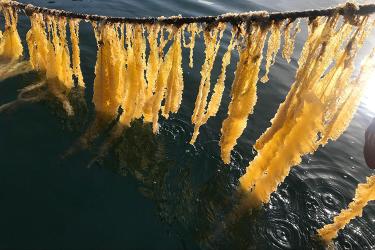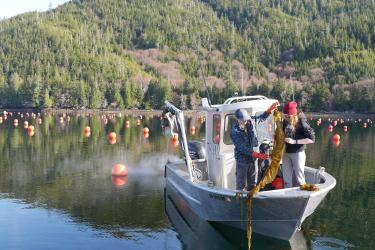The eastern North Pacific right whale is among the world’s rarest and most mysterious great whale populations. With fewer than 50 animals in a vast ocean, these whales are challenging to study. Essential information, including their migration and feeding patterns, remains unknown. But recent analysis is providing insights into their habitat use.
A new study used innovative techniques—using ratios of amino acids in the skin tissue—to uncover a record of migration and foraging. The data was contained in archived whale skin samples collected over three decades. The research was an international collaborative effort by:
- NOAA Fisheries
- Duke University
- University of Washington
- University of New Mexico
- Centro de Investigación Científica y Educación Superior de Ensenada
The results fill a key knowledge gap on eastern North Pacific right whale spring habitat use and feeding. They provide insight into how the whales are responding to a changing marine environment. These findings can inform management and recovery actions for this endangered population. And the innovative approach could have wider applications for other rare whale species.
“Because these whales are so rare, they are hard to study using traditional methods. Fortunately, we have an archived dataset of skin biopsies collected by numerous scientists over the decades that we can use with new laboratory techniques to learn about these whales,” said Dana Wright, NOAA Fisheries affiliate/University of Washington Cooperative Institute for Climate, Ocean, and Ecosystem Studies. “Because so little is known about this population, we have learned so much from this one study. We’ve taken a giant step forward in understanding them.”
Working to Recover a Whale on the Brink
Once abundant, North Pacific right whales were hunted to near extinction during the 1840s. In the 1960s, hundreds of Illegal killings by the former U.S.S.R. further decimated the population. Unfortunately, the eastern North Pacific right whale has not shown signs of recovery.
“It’s hard to pinpoint why these whales have not recovered given how little we know about their ecology and the threats they face,” Wright said.
Understanding migration patterns, feeding, and effects of climate change on these whales is key to their effective management and recovery. A primary goal of the 2013 Recovery Plan was to collect data on seasonal movements and habitat. Determining what the whales are eating, and whether their diet is changing as a result of the changing climate, is also vital.
“We know the whales feed in the subarctic Bering Sea in the summer, but information on where they go the rest of the year is scarce. We have historical whaling data, but those may be inherently biased as they reflect where the whalers were,” Wright said. “And these whales are presumed to eat large zooplankton that are associated with sea ice, which has retreated in recent decades.”
Chemical Tracers Connect Whales, Prey, and their Ocean Environment
The researchers compared stable isotope ratios—chemical tracers—in whale skin with those of their zooplankton prey from different regions of the North Pacific ocean.
“The North Pacific Ocean is made up of distinct oceanographic provinces. These provinces are defined by factors such as temperature, circulation, and nutrients. Because the zooplankton feed close to the bottom of the food web, the chemical tracers in their tissues reflect these ocean processes. And because right whales feed on the zooplankton, the zooplankton chemical tracers provide a road map to where the whales were eating.”
The researchers compiled the zooplankton chemical tracer data from prior publications throughout the North Pacific.
“Because the large-scale ocean patterns in the North Pacific are relatively stable, we were very fortunate to be able to draw from prior zooplankton research in these areas to build our chemical tracer map,” said Wright.
This approach provided powerful insight into the whales’ habitat use during spring and summer and across decades.
| δ13C | δ15N | |||
| Province Region | n | Mean ± SD | n | Mean ± SD |
| ALSK | 67 | -21.1 ± 1.9 | 105 | 7.8 ± 1.8 |
| BERS | 320 | -21.3 ± 1.9 | 367 | 10.6 ± 2.8 |
| CCAL+CAMR+PNEC | 258 | -19.4 ± 1.5 | 303 | 8.9 ± 2.0 |
| KURO+CHIN | 71 | -18.1 ± 1.4 | 299 | 6.7 ± 2.0 |
| NPPF+NPTG+NPSW | 57 | -19.4 ± 1.2 | 93 | 5.1 ± 2.2 |
| PSAE+PSAW | 30 | -22.2 ± 1.7 | 294 | 5.7 ± 1.8 |
Table 1. Zooplankton mean (± SD) δ13C and δ15N values (‰) from grouped Longhurst Province regions used in mixing models. ALSK = coastal Gulf of Alaska; BERS = Bering Sea; CCAL+CAMR+PNEC = southeastern North Pacific; KURO + CHIN = Kuroshio Current and China; NPPF+NPTG+NPSW = North Pacific subtropical gyre and southwest; PSAE+PSAW = Pacific subarctic gyres. Full Province labels are in Appendix S1, Table S3.
Whale skin contains an isotopic record spanning approximately 5 months. Therefore eastern North Pacific right whale skin samples collected in summer could provide information through their diet on the whales’ location in spring.
To access this trove of information, the study analyzed a repository of 44 whale skin biopsy samples collected on northern feeding grounds over a 24-year period (1997–2021).
“Sampling by many scientists over many years made it possible to do this analysis, to take this big step forward,” Wright said.
Using a scalpel, scientists separated each skin sample into three layers. Each layer represents a window in time: the basal layer holds the most recent ecological information, while the surface records the oldest. Analyzing these layers allowed the researchers to trace the location of each whale during the 5 months previous to sampling.
Analysis Reveals Records of Spring Migration, Individual Foraging Strategies, and Climate Shifts
Key findings from the study shed new light on eastern North Pacific right whale migration patterns and response to environmental change. These insights have significant implications for management decisions and recovery actions.
A Critical Gap in Migration and Foraging Patterns Filled
The study found that the whales fed in the Pacific subarctic Gyres province and the coastal Gulf of Alaska province during late spring. Results also hinted that some whales may have been further southeast in an ocean province that includes the California Current, where right whales have been seen with increasing frequency.
“Our results support the hypothesis that right whales are feeding outside of the Bering Sea in spring,” Wright said. ”That provides important information for management regarding their critical habitat.”
These findings also provide a connection between historical sightings and the current population. The distribution uncovered is very similar.
Whale Chemistry Reflects Climate-Driven Ecosystem Shift
The research found surprisingly large variability in stable isotope values over time for a whale that is believed to feed exclusively on large zooplankton. Even the handful of individuals that were sampled more than once showed variability.
“We confirmed that they were eating zooplankton. But we also saw variability that we didn’t expect in the diet signal. These animals are really constrained on what they can eat. We expected every year to have very similar values, but they didn’t,” Wright said. “We were able to trace the variability to shifts in the environment. Decreasing sea ice and warming ocean temperatures are changing the base of the food web. These whales are only one step up. We are able to see it in the whales.”
Northward Movement as Sea Ice Retreats
Evidence from the analysis suggested recent changes in whale behavior and habitat use related to receding sea ice.
“As loss of sea ice changes the food web, these whales seem to be moving around more. That movement includes feeding north of their currently defined critical habitat,” Wright said.
Evidence for Individual Foraging Strategies
“The data suggest that the whales aren’t all doing the same thing. They exhibited individual strategies on the foraging grounds, ” Wright said. “This variability could have important implications for their ability to adapt to a changing marine environment.”
"Overall the study provides reasons for hope for the eastern North Pacific right whale population," Wright says.
“The remnant population appears to be following their historic seasonal patterns. That’s a good sign. At the same time, their apparent shifts in habitat use with the recent changing climate suggests things may be changing. We still don’t know what these shifts mean for the whales. But it’s encouraging to continue to see these rare animals on the feeding grounds. I am very optimistic and hopeful about the future of these whales.”










